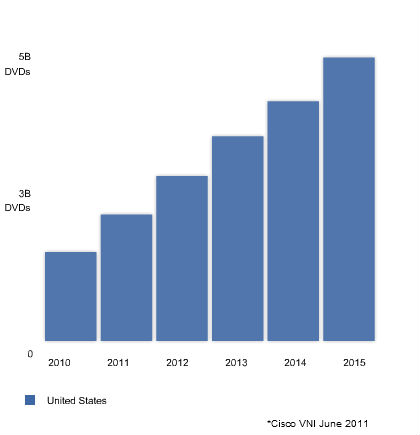Cisco Predicts Four-Fold Growth in IP Traffic Over Next Four years
WASHINGTON June 2, 2011 – Cisco predicted the next four years of global broadband consumption via virtual forum when it unveiled its annual visual networking index Wednesday. Each year Cisco produces a networking index that predicts internet use and broadband consumption for the next five years. Wh
WASHINGTON June 2, 2011 – Cisco predicted the next four years of global broadband consumption via virtual forum when it unveiled its annual visual networking index Wednesday.
Each year Cisco produces a networking index that predicts internet use and broadband consumption for the next five years. While a number of firms produce similar reports, Cisco’s has consistently proven among the most accurate in recent years.
“By doing the report annually we are able to compare our projections to the actual data,” said Suraj Shetty, vice president of global service provider marketing, Cisco. “On average our projections were six to seven percent lower than the actual data.”
This year’s index projects that globally Internet traffic will grow four fold between 2010 and 2015. By 2015, the model portends global traffic will be 80.5 exabytes per month, which is equivalent 17 billion DVDs worth of traffic. In comparison, last year saw 20.2 exabytes of data transmitted per month.
According to Cisco, high definition video will likely see the fastest growth of any content type. The report predicts HD video will grow to 60 percent of all consumer internet traffic by 2015; currently HD video only makes up 40 percent of traffic.
The index also predicts mobile broadband will soon become the main method by which consumers connect to the Internet, using not only tablets, smartphones and computers, but also via Internet-connected appliances and devices such as Blu-ray players, televisions and refrigerators. In North America, the index shows a third of all networked devices will be mobile-connected in 2015.
John Horrigan, Vice President, Policy Research at TechNet said that the world is on the “cusp of the Internet of things – where most of our devices will be connected to the Internet.”
With the predicted large growth in mobile broadband, Blair Levin, Communications & Society Fellow at the Aspen Institute, warned that the U.S. needs to develop a way to reallocate spectrum before the country faces a shortage.
“Every nation needs a plan on how to reorganize or reallocate its spectrum,” Levin said. “If we don’t come up with a plan soon that will work, eventually the government will just take away spectrum from some users and give it others.”
To sustain large growth in data consumption, Cisco projects equally large growth in broadband speeds. The average broadband speed in North America will go from 7.5 megabits per second (Mbps) in 2010 to 27 Mbps in 2015. In comparison, Asia and the Pacific will see the largest growth in speed though from 5.5 Mbps in 2010 to 25 Mbps in 2015. Mobile is also expected to catch up to current fixed line speeds with a projected average global mobile broadband speed of 5 Mbps.
Growth in speed and traffic is not without its downsides, however, said Carlos Rodriguez, manager of regulatory affairs at Telefónica USA. Unless telecommunications firms adjust their business models soon, according to Rodriguez costs will outpace revenue.
“Costs grow as traffic across the networks grows, but revenues have been stagnating,” Rodriguez said. “If not changed, we may face a period where firms are simply unable to invest in improving network infrastructure due to a lack of funding.”
Currently, 80 percent of overall network traffic is consumed by 10 percent of users. Rodriguez suggested that telecommunications providers might have to switch from an unlimited model to offering users different usage levels.
The full report along with an interactive map on broadband data consumption can be found here.









Member discussion